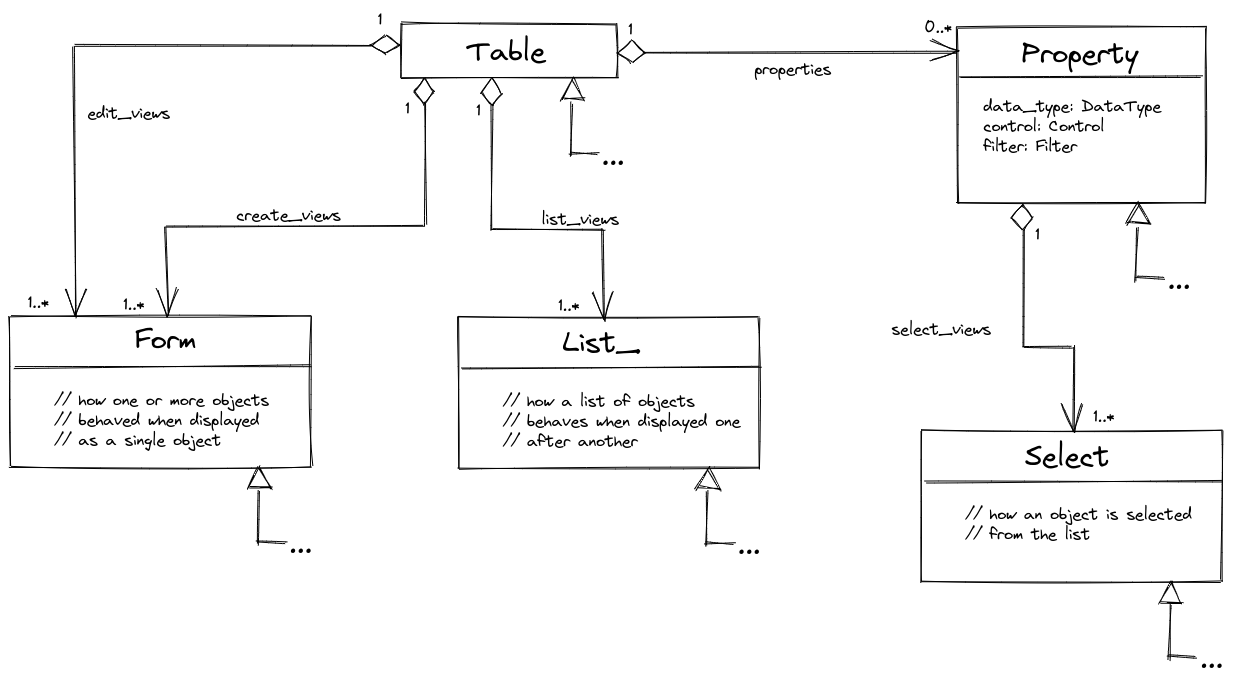Reflection
Version 0.2 ∙ 2 minutes read
Osm Admin knows every tiny detail about your application objects and properties. And you can, too, using reflection.
Status. This specification is a work in progress.
Contents:
UI
Let's start with some diagrams.
UI renders results of query formulas, each having a resolved data type, designated UI control and filter types:

Objects are shown in the UI as views:

Views
There maybe N configured ways to show an object, or a list of objects, and these "ways" are called views.
There are several places in the UI where objects are displayed. Each such place has a dedicated property in the table or class definition. Standard places:
$table->list_viewsare used on the object list page$table->create_views- on the object creation page$table->edit_views- on the object editing page
You can define custom places in the UI by adding more such properties to the table or class definition.
A UI place property, for example $table->list_views, is an array of views, having unique view name in its keys.
A view is shown using ?view=<name> URL parameter.
If the view URL parameter is omitted, the default view, having a predefined name, is used:
$table->list_views['grid']is aGrid$table->create_views['form']is aForm(['mode' => 'create'])$table->edit_views['form']is aForm(['mode' => 'edit'])
A UI place property expects every view in the list to extend some base class. For example, $table->list_views are expected to be instances of List_. The UI route and template code are programmed to the expected base class.
A default view is always there, and can't be deleted. However, you can customize it, and define more custom views.
Views can also be defined in Property classes, for example, $record->select_views.
Implementation note. During rendering a view object is cloned, then rendered, so the rendered view object is not a part of the schema.
Controls
Then, a property or a formula of the same data type, say int, maybe represented in the UI in a number of ways, for example, Input, Select or Hidden. The "way" a property or a formula is represented and behaves in the UI, is called control. All supported controls for a data type are specified in the $dataType->supported_controls property.
Each data type has a default control specified in the $dataType->default_control. For example, by default, int properties are shown as Input.
A property uses the default control of its data type, or any other supported control. Either way, it's in the $property->control property.
null is a valid value for control and default_control properties. It means that the control is not displayed.
Implementation note. During rendering a control object is cloned, then rendered. If a control displays a property, for example, title, it's cloned from $property->control. For more complex formulas, $dataType->default_control is used.
Filters
A property is always filtered using the same URL parameter syntax. For example, int property understands ?qty=5+6+7 and ?qty=10-20+40-50 syntax.
However, there are several ways its filter can be rendered, for example, int property can be displayed as Options or Slider. All supported filters are listed in $control->supported_filters.
Each control has a default filter referenced in the $control->default_filter property.
A property uses the default filter of its control, or any other supported filter. Either way, it's in the $property->filter property.
null is a valid value for filter and default_filter properties. It means that the filter is not displayed.
Implementation note. During rendering a filter object is cloned, then rendered. If a filter is based on a property, for example, title, it's cloned from $property->filter. If a filter is based on a more complex formula, $control->default_filter is used.
What's Missing In This Specification
- schema
- tables and classes
- properties
- implementation status/efforts required
- links to the code base
- comments in the code base (if you open a link to the code base, it should be an easy read)

